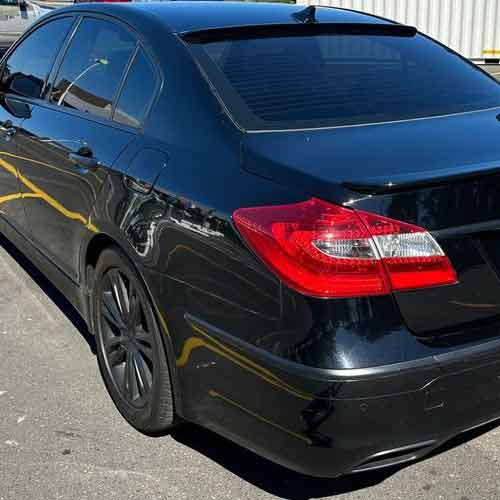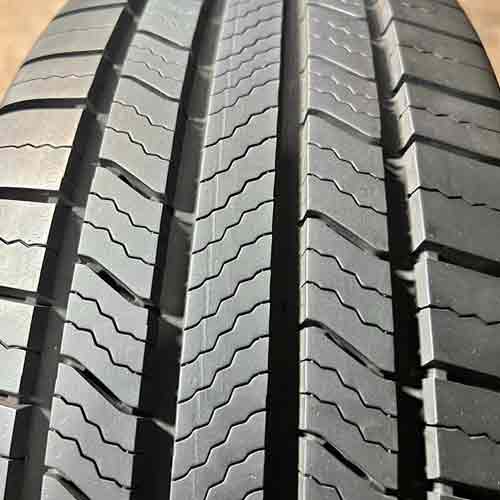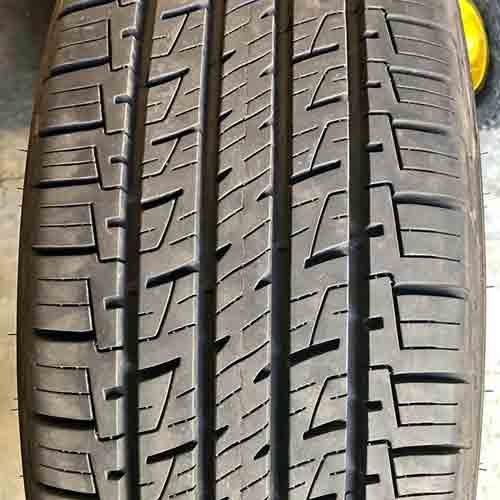Both the Goodyear Assurance Maxlife and the Michelin Defender 2 are leading when it comes to their standard touring all-season category. So it’s going to be a close one. Let’s begin.

Being a tire engineer, my tests show that the Michelin Defender 2 excels in dry performance and cornering with its continuous central ribs, and promises a quieter ride, better fuel efficiency, and impressive tread life with it’s lighter weight. On the other side, the Goodyear Assurance MaxLife offers better wet and winter grip, where its well engineered rubber also offers superior comfort.
Tire Sizes
The Goodyear Assurance MaxLife comes in 15 to 20 inches wheels, and all of those sizes have following specs.
- Speed ratings: H and V.
- Load ratings: SL and XL.
- Tread depth range: 11 to 12/32″.
- Weight range: 20 to 36 lbs.
- Treadwear warranty: 85k miles.
- UTQG rating: 820 A B.
Review this tire in greater details: https://tiredriver.com/goodyear-assurance-maxlife-review/
The Michelin Defender 2 comes in 16 to 20″ inches rims, having following specs.
- Speed ratings: H (on all)
- Load ratings: SL and XL
- Tread depth range: 10.5/32″ (on all)
- Weight range: 25 to 32 lbs
- Winter ratings: Only M+S no 3PMSFR.
- Tread mileage rating: 85k miles.
- UTQG rating: 800 A A.
Review this tire in greater details: https://tiredriver.com/michelin-defender-2-review/
Tread Design
Comparing the tread of both tires, the Michelin Defender 2 comes with more streamlined symmetric structure.

This design consists of five ribs.
The simplistic outer shoulder ribs each have a single wave-like siping slit.
In contrast, the three central ribs boast a more intricate design.
The central rib runs continuously with angled interlocking sipes.
The adjacent ribs showcase curved lateral grooves that connect to the outer circumferential channels, and they too possess similar siping patterns.
Internally, the Defender 2 is built with a single-layer polyester casing, complemented by two steel belts and a nylon cap ply.
Comparatively, the Assurance MaxLife also presents a symmetric tread, its slightly more aggressive.

Though you get similar 5 rib pattern here as well.
Starting with the outer 2 shoulder ribs, they feature F-shaped siping and notches pointing towards the center.
These elements, combined with thick lateral grooves, ensure superior road grip, especially during sharp turns on dry surfaces.
Moving towards the middle, the central most rib has less biters relatively.
Although it also features notches facing both lateral directions, they aren’t as thick as seen on the adjacent ribs.
Moreover, these neighboring ribs also have thicker siping too.
Internally, this tire is crafted with a single ply polyester casing, a single ply nylon cap.
And yes, you also get 2 steel belts, between these two, adding to the tire’s durability.
Pavement Performance Analysis
Dry pavement performance is largely influenced by a tire’s acceleration, braking efficiency, and cornering capabilities, coupled with steering responsiveness.
Let’s get into them.
Directional Grip
When it comes to directional grip, there are two main things to consider.
- It gets measured by the tire’s braking efficacy.
- It depends on the central tread area.
Central area is pretty important here as that’s where most of the weight is concentrated when the tire rolls straight. (Basically that part meets the most with the road).
That’s it makes sense why the Michelin Defender 2 takes the lead with its continuous running (more streamlined) central ribs.
These basically provide you with greater rubber to road contact patch, providing superior longitudinal traction.
On the other hand, the Goodyear Assurance MaxLife lacks due to two main reasons. One, the tire’s multiple notches and thick siping slits eat away the rubber (that could have added to it’s overall contact patch). And two, it comes with a heavier structure. So while maneuvering it generates greater momentum inertia, which is harder to stop in comparison.
But don’t get me wrong here. I mean “lack” seems like a harsh word here when you consider the negligible performance difference between both these tires.
Overall Cornering
The cornering grip of a tire is predominantly determined by its shoulder region. Let me explain, why.
Basically, as the tire corners, the majority of the weight (it carries), shifts to the edges of the tread, leading to enhanced ground contact from there. This, in turn, influences lateral grip and steering responsiveness.
Recognizing this, it’s clear that both tires possess decent cornering abilities. But still overall, the Michelin edges out slightly, showcasing faster handling times (on lap tests).
Although both tires have continuous running shoulder ribs, the ones on Defender 2 still showcase greater minimalism. I mean there are very less tread features there, in comparison, and this contributes to greater shoulder-road contact, enhancing its grip.
Though still, the main problem with the Goodyear Assurance MaxLife is its lagging steering response.
This lag is attributed to its heftier design and greater weight, which results in increased inertia during cornering, inducing more lug flex, and consequently, a delayed steering response.
To put simply, with its lugs bending more compared to Michelin, they waste time to revert to their original form/shape, impacting the overall handling duration.
Wet Performance
Optimal wet grip in tires revolves around two crucial components, abundant siping and appropriate tread flexibility.
But what makes these components so significant in wet conditions?
Well, these sipes “flex” to produce a negative pressure, pulling in water molecules, clearing off the surface for the tread to grip on. So this tells us that, without the right amount of flexibility, sipes can’t effectively expel enough moisture.
And that’s the main reason why Michelin is lacking here.
Although the Defender 2 comes with a lot of intricate sipes with full-depth structures, situated at varied angles across its tread, the tire’s stiffer rubber still don’t allow them to produce as much of the wet traction, compared to Goodyear.
In other words, Michelin’s greater tread rigidity hinders the sipes from absorbing and displacing water as efficiently.
On the other hand, the Assurance MaxLife although also has a stiff rubber (compared to other competitors), its still more pliant in comparison here.
And that coupled with its superior mix of linear and interlocking sipes, this tire demonstrates superior overall wet performance.
Winter Traction
While both tires deliver respectable winter traction, neither has achieved the 3-Peak Mountain Snowflake certification.
For context, this certification indicates that a tire would have approximately 10% better acceleration than standard all-season tires without this designation.
Given this absence of certification, it’s really out there, why both tires aren’t so great overall, especially when it comes to ice traction.
Though in terms of snowy conditions, you still get a decent traction on Goodyear Assurance MaxLife, comparatively.
If you consider its tread pattern again (by scrolling up to the section), you’d note that it comes with more biters, in the form of in-groove notches and substantial siping slits (where on shoulders these are “F” shaped).
These basically offer better snow-to-snow contact, and so you get superior handling, braking and acceleration with this tire.
(This type of contact is better, considering snow’s inherent property to bond more effectively with itself than with rubber).
Ride Smoothness
The overall ride comfort is primarily determined by the tire’s ability to cushion itself against road imperfections. That’s why here how well the tire’s material/composition and construction is made, matters a lot.
And considering the construction of both tires, it can be seen why the Goodyear MaxLife comes out with better overall subjective scores.
The tire aligns with many luxury-oriented all season tires, where it tends to excel mainly with minor road inconsistencies.
And even though it can’t offer a good enough adaptability when it comes to larger bumps, it’s still better compared to the harder rubber composition of Michelin Defender.
The shortfall of the Michelin primarily stems from its stiffer nylon cap ply, especially around the shoulder region.
This rigidity inhibits its capacity to dampen road vibrations as effectively, resulting in a more jittery ride, comparatively.
Fuel Economy
Fuel efficiency in tires is influenced by various factors. And they all combine to define the tire’s rolling resistance.
These factors include, the tire’s inherent weight, encompassing both its inner and outer structure and it’s tread composition (some rubber compounds have polymers which are more sticking towards the road).
Now, taking all these variables into account, the Michelin Defender 2 comes out, showcasing better miles per gallon, comparatively.
This is predominately because the tire comes with a lighter structure, which then reduces the stress on the lugs, minimizing unnecessary flex and subsequently conserving fuel.
(Bending of the lugs, asks for more energy expenditure, where it gets wasted/converted in to heat, and energy required to reshape the tread).
Noise Dampening Ability
The primary source of noise in a tire, arises from the interaction of air particles against the tread walls. Let me explain.
So as the tire rolls, it allows air to enter (mostly through shoulders), and hit around the tread. And impact of that “hitting” translates into noise.
Given this, it’s understandable that the Goodyear Assurance MaxLife, with its more voided structure, underperforms in overall noise dampening performance.
In comparison, the Michelin proves to be a more serene option, emitting only a faint hum that merges seamlessly with the background, all thanks to its J shaped shoulder grooves.
While its shoulder voids have ridges in between, restricting air entry in the first place, its J shaped grooves also help, as they create diverse interaction points for air to collide.
This basically creates a range of sound frequencies, that cancel out each other, resulting in diminished noise.
However, it’s worth noting that the noise difference between the two tires is very marginal, averaging less than a single decibel.
Tread Life
When it comes to evaluating tread life, there are always three main questions to figure out.
- How much tread depth, the tire has?
- What’s it’s compound composition like?
- And what’s its overall construction weight?
And considering these, it can be seen why the Michelin Defender 2, not only excels here compared to Goodyear, but in-fact offers one of the best treadwear performance in the whole all season category.
Constructed with a more durable rubber, where it’s EverTread Technology, enriches its compound with specific polymers, the Defender offers a superior resistance to wear.
Moreover, the tire also offers a very light weight construction, so it’s lugs aren’t pushed down (against the road), a lot, keeping rolling resistance at bay.
And this is further helped by the tire’s rounded contact patch and Michelin’s Max Touch technology, ensuring a balanced weight distribution across the tread, promoting more longevity.
On the other hand, Assurance MaxLife although possesses a deeper tread (which helps longevity), it still doesn’t quite match up, mainly because of its relatively softer rubber compound.
Theoretically speaking, greater tread depth means a longer journey to the 2/32″ (which is the legal tread depth limit in US).
Though don’t get me wrong, the Goodyear is still pretty great and offers similar 85k miles warranty, compared to its counterpart.
For Your Info: Achieving better tread life is the main focus of Michelin Defender 2, that’s why it promises an impressive 24k more miles than its Defender T+H (comparison review).
Take Home Points
So overall it comes down to what you want.
I mean, the Michelin Defender 2 excels in dry performance due to its superior grip and streamlined central ribs, and steering response.
In wet conditions, Goodyear’s flexible tread outperforms Michelin’s stiffer design. And it also helps the tire with snow traction, and overall comfort performance too.
Though the Michelin offers better fuel efficiency and noise dampening, along with tread longevity, though both tires offer similar treadwear warranties.
So, please Dear Expert, which tire is better for my 2014 Rav4? Keep in mind that i intend to only use them for spring, summer and fall in Maine. Studded snows on separate rims will be used in winter.
Thanks!
Go with Defender man.